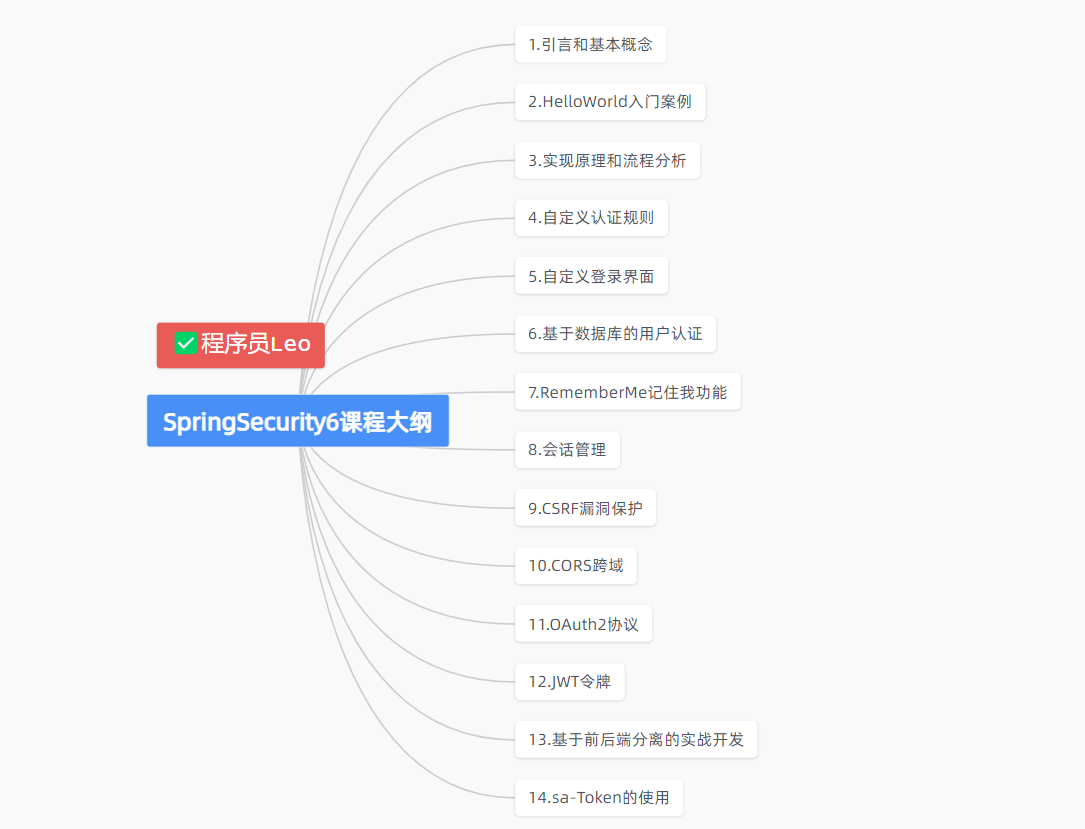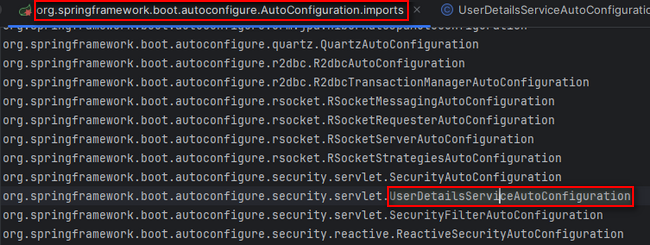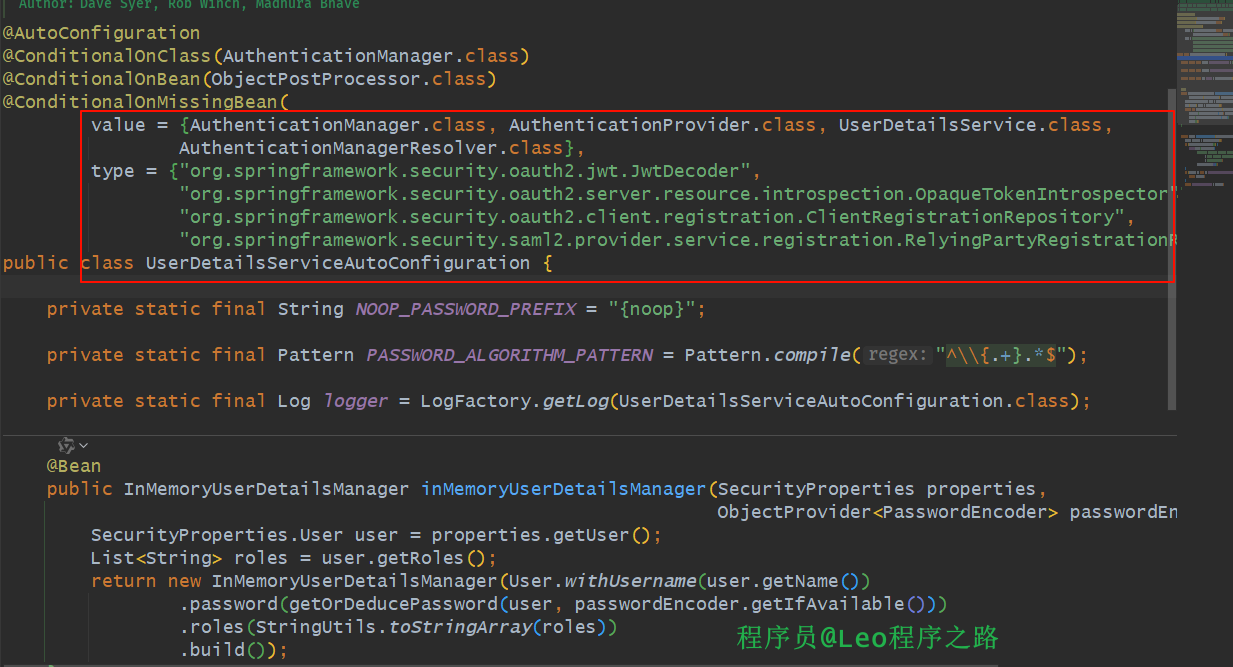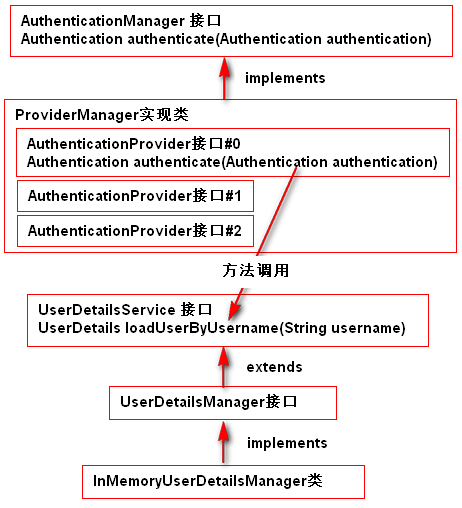默认用户生成(下)
SpringSecurity6 | 默认用户生成(下)

1.前言
大家好,我是Leo哥🫣🫣🫣,接到上一节,我们学习了SpringSecurity默认登录用户是如何来的,也通过源码的方式去验证了我们的猜想。那么本篇文章继续讲解有关最后UserDetailedService这个接口的相关内容。
好了,话不多说让我们开始吧😎😎😎。
2.问题
我们在上一篇文章的时候,最后讲到了UserDetailedService,程序最后也是走到了UserDetailedService的loadUserByUsername()方法,然后基于内存对我们表单输入的用户名和密码进行判断,那这个UserDetailedService
他是如何被SpringBoot加载出来的呢,我们且听后续分享。
3.揭晓
3.1 UserDetailService接口
在 UserDetailService 接口中,loadUserByUserName() 方法用于根据用户名进行认证,默认基于内存实现,不需要有后端数据库的支持。如果想修改成数据库实现,我们只需要自定义 UserDetailService 接口的实现类,并返回 UserDetails 实例即可:

我们来看一下UserDetailService接口的继承结构图

CachingUserDetailsService (位于org.springframework.security.authentication包下)缓存用户详细信息服务,是UserDetailsService 接口的实现之一,获取用户详细信息的源头可以是从缓存中获取,
详细代码如下:
public class CachingUserDetailsService implements UserDetailsService {
// 用户缓存
private UserCache userCache = new NullUserCache();
// 获取用户详情服务接口
// 以免从缓存中没有获取到用户信息
// 可以通过提供的其他方式获取用户信息
private final UserDetailsService delegate;
// 构造器 初始化获取用户信息的其他服务
public CachingUserDetailsService(UserDetailsService delegate) {
this.delegate = delegate;
}
// 获取用户缓存
public UserCache getUserCache() {
return this.userCache;
}
// 设置用户缓存
public void setUserCache(UserCache userCache) {
this.userCache = userCache;
}
// 通过用户名称获取用户详情信息
public UserDetails loadUserByUsername(String username) {
// 从缓存中获取
UserDetails user = this.userCache.getUserFromCache(username);
// 如果从缓存中获取的用户信息为null
if (user == null) {
// 使用其他方式获取用户信息
user = this.delegate.loadUserByUsername(username);
}
// 判断用户信息是否为空
Assert.notNull(user, () -> {
return "UserDetailsService " + this.delegate + " returned null for username " + username + ". This is an interface contract violation";
});
// 不为空则向缓存中添加用户信息
// 下次可以从缓存中获取
this.userCache.putUserInCache(user);
// 返回用户信息
return user;
}
}
UserDetailsManager(位于org.springframework.security.provisioning包下)用户详情信息管理,这个接口不仅继承了UserDetailsService接口拥有通过用户名获取用户详情信息的方法,还定义了许多操作用户的相关方法,如下:
public interface UserDetailsManager extends UserDetailsService {
// 创建用户
void createUser(UserDetails user);
// 修改用户
void updateUser(UserDetails user);
// 删除用户
void deleteUser(String username);
// 修改密码
void changePassword(String oldPassword, String newPassword);
// 用户是否存在
boolean userExists(String username);
}
InMemoryUserDetailsManager (位于org.springframework.security.provisioning包下)内存用户详细信息管理器,这个类实现UserDetailsManager 接口不仅可以获取用户信息还有自己的一套用户信息管理发方式,将用户信息存在在Map中进行管理CIUD操作,虽然很是方便但是对用户数据没有做持久化操作,系统关机时用户信息都会消失;InMemoryUserDetailsManager 还实现了==UserDetailsPasswordService == (位于org.springframework.security.core.userdetails包下)接口用户详细信息密码服务,主要进行优化密码更新并返回用户信息方法:
public interface UserDetailsPasswordService {
// 修改密码 返回用户详情
UserDetails updatePassword(UserDetails user, String newPassword);
}
public class InMemoryUserDetailsManager implements UserDetailsManager, UserDetailsPasswordService {
protected final Log logger = LogFactory.getLog(this.getClass());
// 用于管理用户信息的Map(可以理解为一个没有持久化功能的内存数据库)
// 感觉MutableUserDetails可变用户接口的实现主要为SpringSecurity内部
// 自己的用户管理方式提供存储用户信息的类
private final Map<String, MutableUserDetails> users = new HashMap();
// 认证管理器
private AuthenticationManager authenticationManager;
public InMemoryUserDetailsManager() {
}
// 构造器 初始化用户信息 并添加到map中
public InMemoryUserDetailsManager(Collection<UserDetails> users) {
Iterator var2 = users.iterator();
while(var2.hasNext()) {
UserDetails user = (UserDetails)var2.next();
this.createUser(user);
}
}
// 构造器 初始化用户信息 并添加到map中
public InMemoryUserDetailsManager(UserDetails... users) {
UserDetails[] var2 = users;
int var3 = users.length;
for(int var4 = 0; var4 < var3; ++var4) {
UserDetails user = var2[var4];
this.createUser(user);
}
}
// 构造器 初始化用户信息 并添加到map中
public InMemoryUserDetailsManager(Properties users) {
Enumeration<?> names = users.propertyNames();
UserAttributeEditor editor = new UserAttributeEditor();
while(names.hasMoreElements()) {
String name = (String)names.nextElement();
editor.setAsText(users.getProperty(name));
UserAttribute attr = (UserAttribute)editor.getValue();
Assert.notNull(attr, () -> {
return "The entry with username '" + name + "' could not be converted to an UserDetails";
});
this.createUser(this.createUserDetails(name, attr));
}
}
private User createUserDetails(String name, UserAttribute attr) {
return new User(name, attr.getPassword(), attr.isEnabled(), true, true, true, attr.getAuthorities());
}
// 创建用户并添加到map中
public void createUser(UserDetails user) {
Assert.isTrue(!this.userExists(user.getUsername()), "user should not exist");
this.users.put(user.getUsername().toLowerCase(), new MutableUser(user));
}
// 从map移除用户
public void deleteUser(String username) {
this.users.remove(username.toLowerCase());
}
// 更新map中的用户信息
public void updateUser(UserDetails user) {
Assert.isTrue(this.userExists(user.getUsername()), "user should exist");
this.users.put(user.getUsername().toLowerCase(), new MutableUser(user));
}
// 判断用户是否以存在
public boolean userExists(String username) {
return this.users.containsKey(username.toLowerCase());
}
// 修改密码
public void changePassword(String oldPassword, String newPassword) {
// 从认证上下文中获取认证后的用户信息
Authentication currentUser = SecurityContextHolder.getContext().getAuthentication();
if (currentUser == null) {
// 无法更改密码,因为在当前用户的上下文中找不到身份验证对象
throw new AccessDeniedException("Can't change password as no Authentication object found in context for current user.");
} else {
// 获取用户名称
String username = currentUser.getName();
this.logger.debug(LogMessage.format("Changing password for user '%s'", username));
if (this.authenticationManager != null) {
this.logger.debug(LogMessage.format("Reauthenticating user '%s' for password change request.", username));
// 认证用户信息,检查之前的用户信息
this.authenticationManager.authenticate(new UsernamePasswordAuthenticationToken(username, oldPassword));
} else {
this.logger.debug("No authentication manager set. Password won't be re-checked.");
}
// 从map中获取用户信息
MutableUserDetails user = (MutableUserDetails)this.users.get(username);
Assert.state(user != null, "Current user doesn't exist in database.");
// 设置新的密码
user.setPassword(newPassword);
}
}
// 更新密码并返回用户详情信息
public UserDetails updatePassword(UserDetails user, String newPassword) {
String username = user.getUsername();
MutableUserDetails mutableUser = (MutableUserDetails)this.users.get(username.toLowerCase());
mutableUser.setPassword(newPassword);
return mutableUser;
}
// 通过用户名称从map中获取用户详情信息
public UserDetails loadUserByUsername(String username) throws UsernameNotFoundException {
UserDetails user = (UserDetails)this.users.get(username.toLowerCase());
if (user == null) {
throw new UsernameNotFoundException(username);
} else {
return new User(user.getUsername(), user.getPassword(), user.isEnabled(), user.isAccountNonExpired(), user.isCredentialsNonExpired(), user.isAccountNonLocked(), user.getAuthorities());
}
}
// 设置认证管理器
public void setAuthenticationManager(AuthenticationManager authenticationManager) {
this.authenticationManager = authenticationManager;
}
}
3.2 UserDetailServiceAutoConfigutation类
在 SpringBoot 的自动装配中,默认会启动配置类 UserDetailServiceAutoConfigutation :

在配置类 UserDetailServiceAutoConfigutation 默认生效时会提供 InMemoryUserDetailManager 的实例,也就是基于内存的实现。
配置类 UserDetailServiceAutoConfigutation 默认生效的条件有三种情况:
- 在 classpath 下存在 AuthenticationManager 类
- 当前应用中,存在 ObjectPostProcessor 类的实例时
- 当前应用中,不存在 AuthenticationManager.class、 AuthenticationProvider.class、UserDetailsService.class、 AuthenticationManagerResolver.class 的实例时
我们接着去看看 UserDetailServiceAutoConfigutation这个类的具体实现

我们来看看@ConditionalOnMissingBean这个注解,他是核心。
@ConditionalOnMissingBean是一个注解函数,用于在SpringSecurity中条件地检查是否缺少指定类型的bean。如果缺少指定类型的bean,则会执行一些特定的操作。在此例中,如果缺少AuthenticationManager、AuthenticationProvider、UserDetailsService、AuthenticationManagerResolver类型的bean,以及JwtDecoder、OpaqueTokenIntrospector、ClientRegistrationRepository、RelyingPartyRegistrationRepository类型的bean,将会执行相应的操作。
我们这里的表单验证,并没有对UserDeatilService这个接口进行实现,并没有对以上bean进行激活,所以他就是直接走了默认的配置。
4.小结

我们可以通过自定义 UserDetailService 接口的实现类,可以修改默认认证规则。
5.总结
以上便是本文的全部内容,本人才疏学浅,文章有什么错误的地方,欢迎大佬们批评指正!我是Leo,一个在互联网行业的小白,立志成为更好的自己。
如果你想了解更多关于Leo,可以关注公众号-程序员Leo,后面文章会首先同步至公众号。

